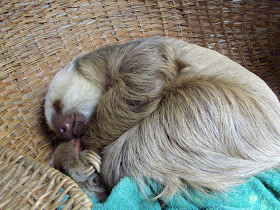
The first time I saw a sloth I was taken aback by its strangeness: the length of its forearms, the broad grin, the slowness of its reach. Days later I found an arm, decaying and sea soaked and was amazed by how similar it seemed to my own, and how alien it looked ending in sharp talons rather than a hand. I became able to spot the three fingered sloths high in trees sitting sagely watching the world, and came to regard them as benevolent forces in the rainforest, silent watchers of the world: their unending smiles a reflection that indeed all would be well.
There are two types of sloth in Costa Rica: the Pale throated three toed sloth (Bradypus tridactylus) and Hoffman's Two toed sloth (Choloepus hoffmanni). They are as closely related to one another as they are to their cousins the anteaters and the armadillos. The three toed is diurnal, and the two toed nocturnal.
The sloth is a fascinating creature and a monument to natural survival. Central and South America was once home to giant ground sloths as big as elephants which were hunted to extinction. However the species adapted to save itself, resulting in the varieties of two and three toed sloths which are seen today. The sloth has scaled the trees, diminished greatly in size and taken on several protective aspects which have ensured its survival.
The three-toed sloth
Almost everything about a sloth is slow (they scratch at normal speed), and for good reason – energy conservation. Their diet of leaves, twigs and buds provides little protein or energy and they lack any enzyme to break down the cellulose present in the leaves. Sloth digestion is very slow – it takes about 4 weeks for food to move through their system, and they rely, as Howler Monkeys, on internal fermentation to release nutrients.
Due to their slow metabolism, sloths have low, though variable, body temperatures. They are easy to spot in the early morning as they must find a warm open area to soak up the sun. The sun provides the energy and heat to raise their body temperatures and boost their fermentation process. During wet seasons, especially when there are many cloudy days, sloths can die from starvation even with full stomachs because they don't have the heat to ferment their food. It takes 4 weeks for the sloth to digest one meal.
While a sloth feeds from as many as 40 trees, they will spend most of their time in just a few and each will have a favourite tree. In Costa Rica the Cecropia tree is called the sloth tree as these are often the best places to spot sloths. The Cercropia is not everyone’s favourite, but they do seem favoured by many and the tree’s open branches and large, fairly sparse leaves allow for good sloth spotting.
Once a week the sloth will descend from the safety of the canopy to urinate and defecate. The three toed sloth digs a small hole with its tail, and when finished with his weekly business will cover the hole with leaves. A sloth will routinely shed about a third of his body weight in his weekly visit. Coming down to the ground is a dangerous business, the sloth moves very slowly down and back up the tree often using the opportunity to change trees. His speed could be seen as a method of protecting himself – already well camouflaged , his slow movements do not alert any would be predators of his whereabouts. Burying his waste would also help disguise his presence.
Sloths have thick shaggy coats which act as insulation for their low body heat. The hairs are very unusual in that they have cracks (three toed sloth) or channels (two toed sloths) which provide an ideal environment for certain types of green algae. This algae grows throughout the fur and gives an overall green tinge to the coat. No-one really knows why this relationship exists but it is thought to act as camouflage. It is also believed that the algae is able to pass nutrients to the sloth through his skin. The coat also provides a home for the sloth moth, beetles and mites. Each adult sloth can play host to 100 moths and a thousand beetles. The entire life cycle of beetle and moth is connected with the sloth, each spending its larval period in sloth dung, and their adult period eating the algae. What the sloth gets out of this special relationship we don’t quite know.
The two toed sloth
The two toed sloth is nocturnal and very difficult to spot: during the day he curls his head to his belly and looks like part of the tree he's sleeping in. The two toed are omnivorous and have sharp canines, it's believed they will eat lizards and birds or eggs when they find them in the trees. The metabolism of the two toed is different from that of the three toed, being nocturnal it cannot rely on the sun to aid fermentation. The two toed survives better in captivity, where it is a more gregarious and social creature than its three toed cousin.
The biggest threats facing sloths in Costa Rica are loss of habitat, electrical wires and poaching.
Aviarios is an incredible sloth resource and rescue center here on the Caribbean coast. Beginning over 17 years ago with the rescue of Buttercup, the center has gradually become the foremost research establishment for sloths worldwide. Visitors can meet several adult and baby rescued sloths and enjoy their calm presence. It's a wonderful place to visit and offers sloth adoption to help with the costs of caring for these animals.
The poor sloth looks so sweet and innocent.. ~ bangchik
ReplyDeleteInteresting post, Ancel. I've learned so much more about this beautiful animal. The digestion process is amazing.
ReplyDelete